Archived Storm Damage Blog Posts
Lightning Safety Tips: Protecting Yourself and Your Property
6/26/2024 (Permalink)
 Stay Safe During Storms!
Stay Safe During Storms!
Lightning strikes are a natural and awe-inspiring phenomenon, but they can also be incredibly dangerous. Each year, lightning causes numerous injuries, fatalities, and property damage. Our team prioritizes your safety and well-being. Here are some essential lightning safety tips to help you stay safe and protect your property during thunderstorms.
1. Stay Indoors During Storms
The safest place to be during a thunderstorm is indoors. As soon as you hear thunder, seek shelter immediately. Avoid using electronic devices connected to wall outlets, as lightning can cause power surges. If you're inside a building, stay away from windows, doors, and any metal objects that can conduct electricity.
2. Avoid Water and Plumbing
Water is an excellent conductor of electricity. During a thunderstorm, avoid using plumbing fixtures such as sinks, bathtubs, and showers. Lightning can travel through pipes and water systems, posing a risk of electrocution.
3. Unplug Electronics
To protect your electronics from power surges caused by lightning strikes, unplug them before the storm hits. This includes computers, televisions, and other valuable devices. Using surge protectors can also help reduce the risk of damage.
4. Avoid Outdoor Activities
If you’re caught outside during a thunderstorm, find shelter immediately. Stay away from open fields, hilltops, and bodies of water. Avoid tall objects like trees, poles, and metal fences, as they attract lightning. If no shelter is available, crouch low to the ground with your feet together and minimize contact with the ground.
5. Stay in Your Car
If you’re driving when a thunderstorm begins, stay in your vehicle. Cars provide good protection against lightning due to their metal frame. However, avoid touching metal surfaces inside the car during the storm.
6. Wait It Out
Wait at least 30 minutes after the last clap of thunder before leaving your shelter. Thunderstorms can produce multiple lightning strikes even after they seem to have passed.
7. Prepare Your Home
Install lightning rods on your home to direct strikes safely into the ground. Ensure that your home’s electrical system is grounded correctly. Regular maintenance and inspection of these systems can help reduce the risk of lightning-related damage.
8. Know the Signs
If you see dark, towering clouds and hear distant thunder, take it as a sign to prepare for a potential thunderstorm. Stay informed about weather conditions through reliable sources and follow any advisories or warnings.
9. Educate Your Family
Teach your family members about lightning safety and create a plan for what to do during a thunderstorm. Ensure that everyone knows the safest places to seek shelter and the actions to avoid.
10. After the Storm
Once the storm has passed, inspect your property for any damage. If you notice any issues such as electrical problems, water leaks, or structural damage, contact professionals for immediate assistance. SERVPRO Team Spinner is here to help with post-storm cleanup and restoration, ensuring your home returns to its safe and comfortable state.
Be Prepared and Stay Safe
Lightning safety is crucial for protecting yourself, your loved ones, and your property. By following these tips, you can reduce the risk of injury and damage during thunderstorms. If your property does suffer damage from a lightning strike, trust our team to provide prompt and professional restoration services.
Stay safe, stay informed, and remember that SERVPRO Team Spinner is here to help you through any storm. Contact us for assistance with storm damage restoration and ensure your home is always protected.
5 Best Practices for Mobilizing During a Storm
5/3/2024 (Permalink)
 You've got a big storm coming? Here's what to do.
You've got a big storm coming? Here's what to do.
As a leader in disaster recovery and mitigation, SERVPRO Team Spinner understands the importance of preparation and readiness when it comes to severe weather events. Whether it's a hurricane, tornado, or severe thunderstorm, mobilizing effectively can make all the difference in ensuring the safety of yourself, your loved ones, and your property. In this blog post, we'll share five best practices for mobilizing during a storm, along with a call to action to encourage proactive preparedness.
1. Stay Informed: Keeping informed about weather forecasts and updates is essential for making informed decisions during a storm. Use reliable sources of information such as NOAA Weather Radio, weather apps, or local news outlets to stay abreast of changing weather conditions and potential risks.
2. Prepare an Emergency Kit: Assemble an emergency kit containing essential supplies such as non-perishable food, water, flashlights, batteries, first aid supplies, medications, and important documents. Make sure your kit is easily accessible and includes enough provisions to sustain you and your family for at least 72 hours.
3. Secure Your Property: Take proactive measures to secure your home and property against potential damage. Reinforce doors and windows, trim trees and shrubs, and secure outdoor furniture and equipment. Consider installing storm shutters or boarding up windows to protect against high winds and flying debris.
4. Have a Communication Plan: Establish a communication plan with family members, neighbors, and loved ones. Designate a point of contact outside the affected area who can serve as a central coordinator for communication and information sharing. Ensure that everyone knows how to reach each other in case of separation or evacuation.
5. Follow Evacuation Orders: Heed evacuation orders issued by local authorities. If instructed to evacuate, do so immediately and follow designated evacuation routes to safety. Take only essential items with you and leave early to avoid traffic congestion and hazardous conditions.
Don't wait until the next storm is on the horizon to prepare. Take action now to ensure that you and your loved ones are ready to weather any storm that comes your way. Browse our website for more information on storm preparedness and to learn how our team can help you recover and rebuild in the aftermath of a severe weather event. Together, we can weather the storm and emerge stronger on the other side.
Be Prepared: Simple Storm & Flood Tips That Could Save You in an Emergency
10/4/2023 (Permalink)
Natural disasters can strike unexpectedly, and when they do, it's essential to be prepared. Storms and floods are among the most common weather-related emergencies that homeowners face. At SERVPRO® of Hamilton & South Trenton, we understand the importance of being proactive in protecting your home and loved ones. In this blog post, we'll share simple yet effective storm and flood preparedness tips that can make a significant difference during an emergency.
1. Create an Emergency Kit:
A well-prepared emergency kit can be a lifesaver during a storm or flood. It should include essential items such as non-perishable food, water, flashlights, batteries, a first-aid kit, blankets, and important documents (e.g., identification, insurance papers). Make sure your kit is easily accessible and up to date.
2. Stay Informed:
Keep yourself informed about weather forecasts and potential storm warnings. Sign up for weather alerts on your smartphone and have a battery-operated weather radio on hand. Knowing when a storm or flood is expected can give you valuable time to prepare or evacuate if necessary.
3. Secure Your Property:
Before a storm hits, take preventive measures to secure your property. Trim overhanging branches and clear debris from gutters and downspouts to prevent water damage. Consider investing in storm shutters or impact-resistant windows to protect against high winds and flying debris.
4. Elevate Important Items:
If you live in a flood-prone area, elevate valuable items and utilities in your home. Move electrical systems, appliances, and valuable possessions to higher floors or platforms. Elevating your furnace, water heater, and electrical panel can minimize damage.
5. Have an Evacuation Plan:
Develop a family evacuation plan in advance. Identify safe evacuation routes and meeting points. Ensure that everyone in your household knows the plan, including how to turn off utilities if needed. Don't forget to include your pets in your evacuation plan.
6. Protect Your Basement:
Basements are especially vulnerable to flooding. Install a sump pump and consider a battery backup system to prevent water buildup. Waterproof your basement walls and floors to minimize water infiltration during heavy rains.
7. Insurance Check-Up:
Review your homeowner's insurance policy to ensure you have adequate coverage for storm and flood damage. Understand your policy's terms, limitations, and deductible. Consider adding flood insurance if you are in a flood-prone area.
8. Stay Safe During the Storm:
During the storm, stay indoors, away from windows, and avoid using electrical appliances. If the authorities issue an evacuation order, follow it promptly. Never attempt to drive through flooded roads, as it's difficult to gauge the water's depth and strength.
By following these simple storm and flood preparedness tips, you can significantly improve your ability to weather the storm and protect your home and loved ones. Remember that safety should always be the top priority. In the event of storm or flood damage, SERVPRO® of Hamilton & South Trenton is here to help you with water damage restoration and cleanup. Stay informed, stay safe, and be prepared for whatever Mother Nature may bring your way.
Have Storm or Flood Damage? Call Us Today - (908) 650-8611
Understanding the Basics of Damaging Winds
10/3/2022 (Permalink)
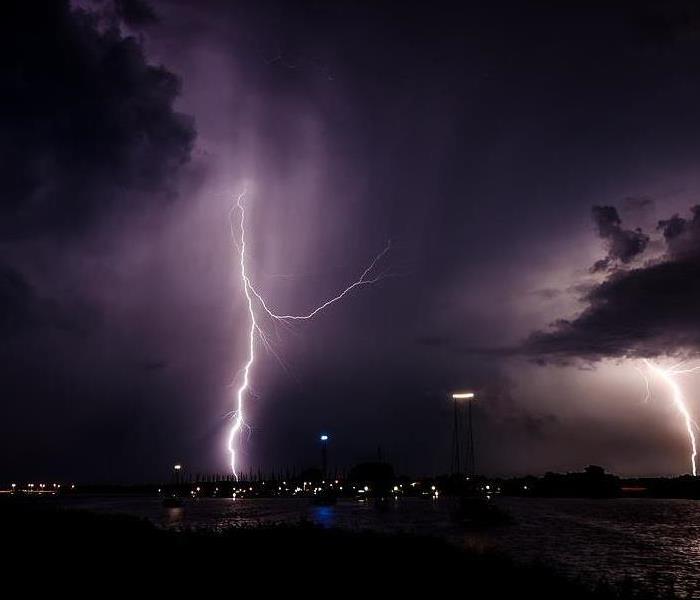 Winds and storms can be dangerous. Read these tips to understand the basics.
Winds and storms can be dangerous. Read these tips to understand the basics.
Damaging winds are one of the threats that comes with severe storms. These winds can catch you off guard and be problematic due to long-term structural impacts.
Why Damaging Winds Are Such a Major Concern
Tornadoes and hurricanes are not the only times damaging winds occur. Damaging winds are considered winds with wind speeds exceeding 50–60 mph and can be produced by a strong thunderstorm. Often, you will hear damaging winds referred to as “straight-line” winds to differentiate the damage from tornado damage.
The damage from straight-line winds can be especially destructive, often causing unanchored objects to become projectiles. Any windows or roof can take the brunt of this damage. If the damage is extensive, it can result in water damage to the home as outside elements come indoors through broken windows or damaged roofs.
Anyone who lives in a thunderstorm-prone area can be at risk from damaging winds, but there are some structures, such as mobile homes, especially at risk. Mobile homes, even those that are anchored, could sustain serious damage in winds gusting over 80 mph.
Ways to Prepare Your Home
There are a number of things you can do to protect your property from damaging winds, but there are two things to remember, keeping the “Two R’s” in mind: reinforce and remove.
Look into having your garage door reinforced by a professional.
Ensure that any loose objects on your property that could become wind-borne are properly stored or anchored. Remember that trash cans, grills and outdoor furniture are easily picked up by strong winds.
Larger, older decaying trees and branches should be professionally removed, which will ensure they cannot be blown onto your home.
Remember, high winds can occur without advanced notice. By taking some, or all, of the above actions, you can be prepared on a moment’s notice.
Also, if you are building a new home or renovating an older home, be sure windows, walls and doors are up to code for your area.
If your home has been hit by damaging winds and resulting water damage, the highly trained specialists at SERVPRO® of Hamilton & South Trenton are here to help with the cleanup and restoration of your home.
Understanding Thunderstorm Damage
7/18/2022 (Permalink)
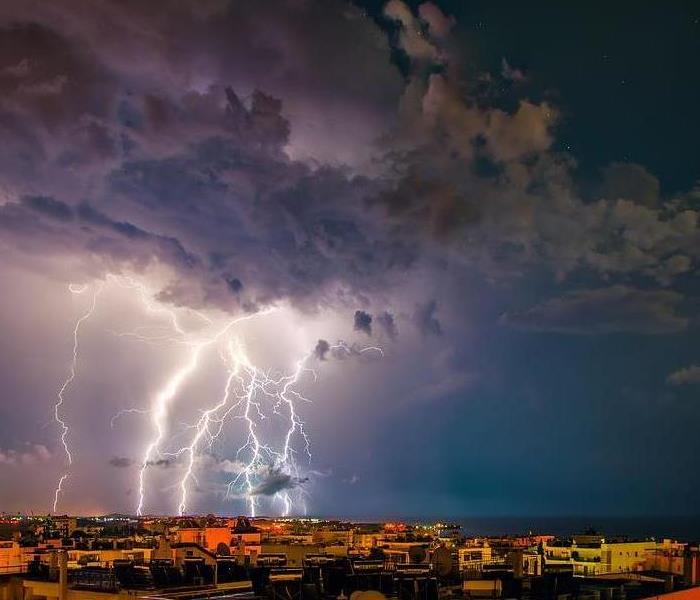 If you experience damage from a thunderstorm, reach out to us 24/7.
If you experience damage from a thunderstorm, reach out to us 24/7.
Thunderstorms are a regular occurrence during the warmer spring and summer seasons, bringing along the risk of damage to your property.
Thunderstorms come in varying levels of intensity. Do you know what those are?
Understanding Thunderstorms
Across the world, an average of 16 million thunderstorms occur each year. The U.S. can see upward of 100,000 thunderstorms annually, with an estimated 10% earning severe status.
Thunderstorms need certain conditions to be met in order to form. Moisture and rising unstable air are required, along with a “lifting” mechanism, which could be things like hills or mountains that force air to rise, or where warm/cold or wet/dry air bump together, causing that rising motion.
There are three stages in a thunderstorm’s life cycle. Those are the developing stage, the mature stage and the dissipating stage. It is during the mature stage that things like hail, strong rain, lightning, high winds and tornadoes are most likely to occur.
Common Types of Damage
Thunderstorms can prove dangerous in many different ways, but an extremely serious threat stems from the possibility of seeing flying debris due to high winds.
During severe storms, wind can see speeds in excess of 57.5 mph, and that is certainly high enough to result in damage to your property.
Even the most unexpected items could reach projectile status during a high wind situation. A smart thing to do is make sure you have scouted your yard for items that could turn dangerous, such as tree branches, lawn furniture, and fencing, and then taken steps to secure them before a storm comes into town.
Besides wind damage, thunderstorms can also produce these types of damage:
Lightning damage. Not only can lightning strikes cause a fire, they can also wreak havoc on your electrical systems. Since a lightning strike can pass through the wiring of your home, it can lead to the damage of anything plugged in.
Tornado damage. With wind speeds that can reach as high as 200 mph, tornadoes are especially destructive. They are able to cover a large area and do their damage in a limited amount of time.
Hail damage. Believe it or not, hail damage can top out around $1 billion a year. Small hail can damage crops throughout the country, while larger hail can damage vehicles, roofing and windows.
Flood damage. Rain almost always accompanies a storm, so it should not come as a surprise that heavy rains can turn into flood danger. Flash flooding can have the strength to rip trees out of the ground and sweep items and structures away.
The Dangers of Lightning during a Storm
7/18/2022 (Permalink)
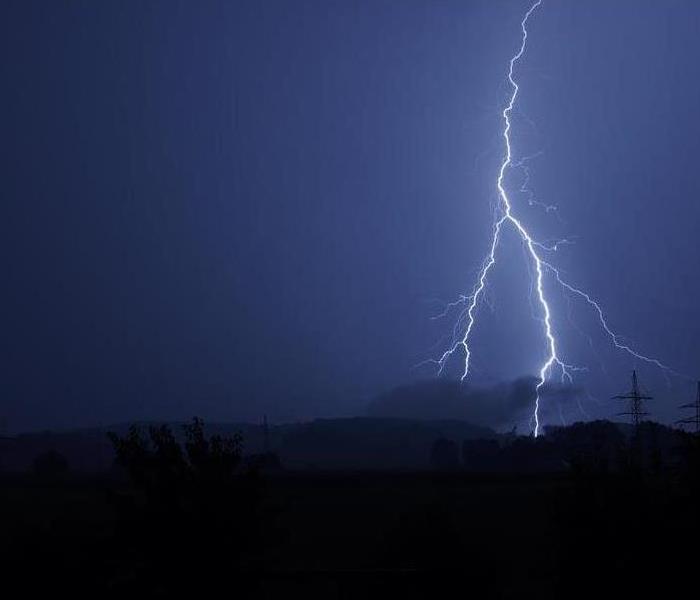 Lightning can be damaging, call us if you need our help.
Lightning can be damaging, call us if you need our help.
There are many ways in which a thunderstorm can cause damage. Flooding or wind damage are what often come to mind, but it is also important to consider the risks associated with lightning when discussing thunderstorms.
While some storms bring rain and water, every storm is made up of electricity, creating the possibility for lightning even in the absence of precipitation. Lightning bolts can be up to 500,000 degrees, causing damage and even fatalities when they strike. An understanding of what lightning is and how it can be dangerous is extremely helpful in helping homeowners prevent these risks.
How Thunderstorms and Lightning Coexist
All thunderstorms contain the electricity that makes a lightning strike possible. What we know as a lightning strike is actually a rapid burst of electricity that occurs when this charge becomes agitated.
The atmosphere is not an ideal conductor, which is why lightning tends to strike objects—this creates a less resistant route in getting to the ground. When a home is the object that has been struck, lightning will usually forge this path through water pipes and wiring.
How Lightning Is Dangerous to Homes
While there are many dangers surrounding thunderstorms, there are [three main ones involved with lightning striking a house]:
The risk of fire. One of the biggest dangers of a lightning strike to a house is the fire hazard it causes. Lightning is hot enough to ignite building materials, causing a fire to break out at the point of impact. Additionally, lightning traveling through wires can cause them to fray, creating fire hazards all throughout the home.
The risk of power surges. Because of the electrical charge at play with lightning, it can easily transfer that to the wiring in the home. This is what we call a power surge, which can affect any electronic device plugged in that is not routed through a surge protector.
The risk of shock waves. Shock waves are typically manifested in thunder, but they can also occur at the site of a lightning strike. Shock waves have been known to crack chimneys, break windows and explode cinder blocks, making them extremely hazardous to a home’s structure.
If your home has been affected by storm damages or lightning-related fires, give us a call today! We are experts in damage cleanup and can restore your damage quickly.
How to Prepare your Family for Storms
7/18/2022 (Permalink)
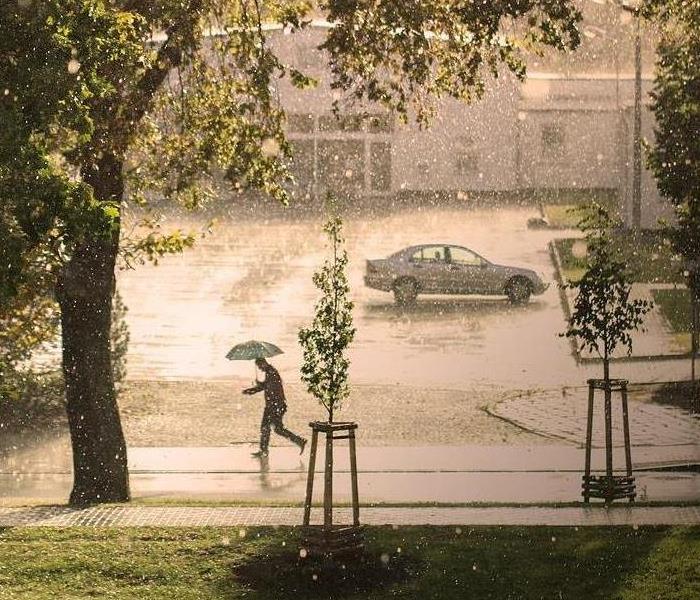 It is important to prepare for storms.
It is important to prepare for storms.
Today, we are fortunate to have advance warning for some types of severe weather, but there are also times where Mother Nature manages to catch us by surprise.
Fortunately, there are steps you can take and safety tips to follow that will guide you in preparing for your family’s safety in various severe weather occurrences.
Where to Start
One of the best ways to ensure your family’s safety is to have an established family emergency plan at the ready.
Be sure to go over your plan together as a family at the beginning of each weather season if there is an emergency plan in place so everyone knows exactly what to do.
Here are some things to take into consideration when creating your family emergency plan if you have not yet done so:
1. How will emergency alerts and warnings be received?
Thanks to technology today, emergency alerts and warnings are at our fingertips with our smartphones that are equipped with a weather app or Google. We can quickly receive emergency alerts, that provide us with valuable time in severe weather situations. Warnings and alerts are also still broadcast over radio and TV.
2. What type of storm shelter do you have?
Where tornadoes are a common occurrence, you’ll want to be in the lowest part of your home, preferably a basement, or if there is no basement, use an interior room on the lowest level that is away from corners, windows, doors and outside walls. Tornadoes aren’t the only weather circumstance that require a form of storm shelter, and you can learn about more of the situations that call for them by visiting ready.gov.
3. What are the evacuation routes?
Have you mapped out multiple evacuation routes because hurricanes, flooding and fires can force you from your home at a moment’s notice. It’s wise to have multiple routes in the event one is impassable, and be sure you find places to stay with your pets along the way if you have furry family members involved in your evacuation.
4. How will everyone stay in touch?
Cell phones are the easiest way to keep in touch with your family, but in some circumstances, that just will not be possible. Cell phone towers can be damaged and phones could be lost or left behind; not to mention batteries will not last forever and there will be no power to recharge them.
Your family should have an emergency communication plan in place as well as a safe meeting place so that you can all meet there if separated.
If a storm does cause damage to your home or business, don’t hesitate to call your friends at SERVPRO® of Hamilton & South Trenton to get the cleanup and restoration process started.
SERVPRO is ready for any storm
7/18/2022 (Permalink)
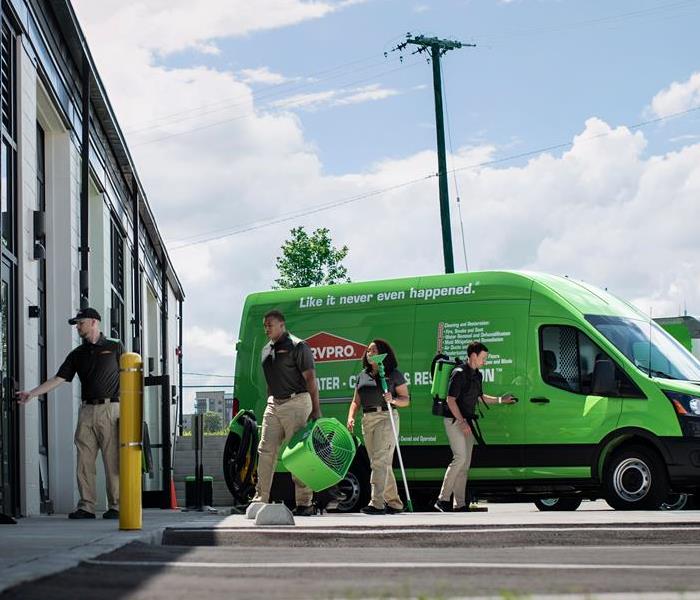 SERVPRO Hamilton & South Trenton is ready to help you.
SERVPRO Hamilton & South Trenton is ready to help you.
SERVPRO of Hamilton & South Trenton specializes in storm and flood damage restoration. Our crews are highly trained, and we use specialized equipment to restore your property to its pre-storm condition.
Faster Response
Since we are locally owned and operated, we are able to respond quicker with the right resources, which is extremely important. A fast response lessens the damage, limits further damage, and reduces the restoration cost.
Resources to Handle Floods and Storms
When storms hit Hamilton and South Trenton, we can scale our resources to handle a large storm or flooding disaster. We can access equipment and personnel from a network of over 1,650 Franchises across the country and elite Disaster Recovery Teams that are strategically located throughout the United States.
Have Storm or Flood Damage? Call Us Today at (609) 604-8241
Places To Find Cash After A Disaster
7/1/2022 (Permalink)
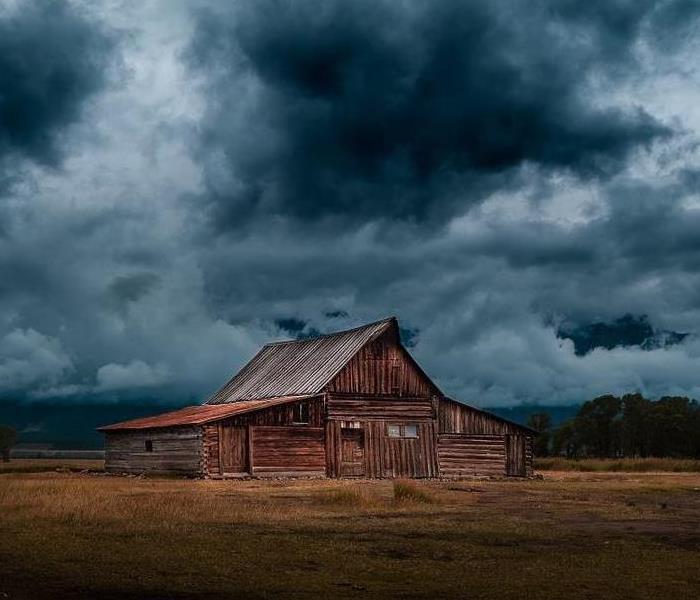 A home in an area with a storm.
A home in an area with a storm.
It happens when you least expect it, and you certainly don't plan for it. The natural disaster, like a flood, fire or any other type of personal catastrophe that leaves you in dire need of liquid funds.
Self preservation requires cash. If you’re hit with an emergency and need to find cash fast, of course, the first place to look are your bank accounts. If these funds are not sufficient, then look to these resources.
1. Family and Close Friends
If you need to find cash fast, ask your family and friends. If they can help, remember to always treat this as a loan and never treat it casually.
If you need to, attach an interest rate and a payment time frame, as you would any official loan from a financial institution. This is important because your family or friend have to charge you something for the transaction to be considered a loan and not a gift that could have tax and estate planning implications.
2. The Government
FEMA is able to provide disaster assistance for such needs as temporary housing, home repair, disaster-related medical expenses, vehicle damage and cleanup costs. Another source, the U.S. Small Business Administration (SBA) offers federally subsidized loans for renters, private nonprofit organizations and home and business owners.
Here's the catch...to qualify for either a FEMA or SBA loan, you must live in a federally declared disaster zone and file a claim with their insurance company first.
3. Life Insurance
Permanent life insurance policies are great resources because they’re readily accessible funds. The can be borrowed against without having to qualify for a loan, and you can pay a policy loan back on your own schedule.
However, rules will vary with insurance providers. Many require policyholders to own their policies for a few years before they can qualify to borrow. You’ll also be charged interest for taking out a policy loan.
4. CDs, Savings Bonds and Mutual Funds / Stocks
CD's: You can take your money out of a CD, but you’ll likely pay a penalty. Sacrificing some earnings is a relatively insignificant compared to paying interest rates on a life insurance loan.
Savings bonds: Savings bonds are another quick cash resource. You might need to pay a three-month interest penalty if a bond is redeemed too early though. In both cases, of course you’ll pay income tax on any interest earned.
Mutual Funds: You can sell stocks as well as mutual funds and annuities. If you take this route, consult your financial adviser about likely tax issues and penalties.
5. College 529 Savings
You may need to borrow from your future to pay present obligations. You 529 College Savings Account is a good resource for this. However, according to the Securities and Exchange Commission, those who withdraw funds out of a 529 plan for non-qualified education expenses will pay income tax and a 10 percent penalty on any earnings.
6. Retirement Accounts
Retirement accounts can be used to fund personal financial needs. It's important to understand the long term personal retirement planning impact. So plan accordingly and know the difference between a Roth IRA and a traditional IRA.
Roth IRA holders may withdraw their own contributions — not earnings — without tax or penalty.
Traditional IRA holders may start taking penalty-free distributions on their accounts if they begin taking regular distributions, but specific rules apply. You’ll pay income taxes and a 10 percent penalty on the taxable amount if you’re under age 59½.
7. A 401(k) Loan
A 401(k) loan is usually a better option than using a 529 or IRA loan.
401(k) holders can borrow up to half of their account balance, up to $50,000, tax-free, but, in most cases, funds must be repaid within five years.
The shortcoming is that you have to stay with your current employer for the duration of the loan period. If you leave your job, you’ll have 30 to 60 days to repay the loan or face penalties.
Before pulling funds from any long-term investment, read the fine print and always consult your tax adviser.
Contact us at (609) 604-8241 if you have a service need or click here to visit our website to learn more about SERVPRO of Hamilton & South Trenton System Services.
Lightning in a Thunderstorm
7/1/2022 (Permalink)
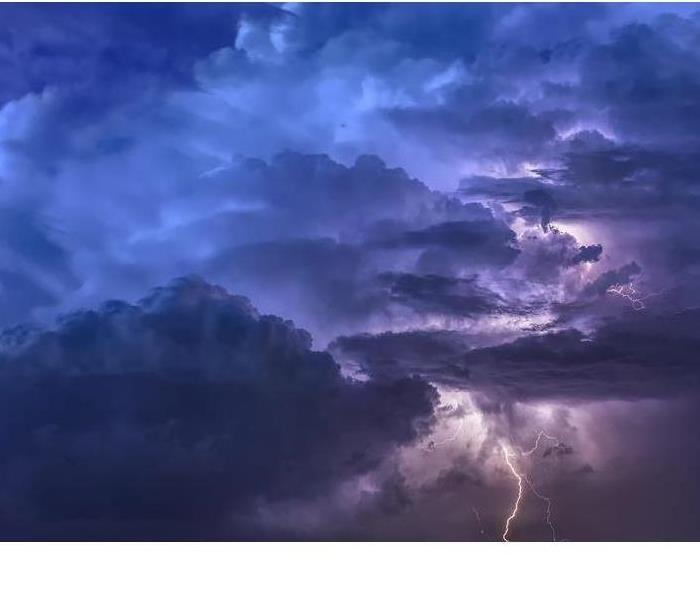 Lightning in the sky.
Lightning in the sky.
There are many ways in which a thunderstorm can cause damage. Flooding or wind damage are what often come to mind, but it is also important to consider the risks associated with lightning when discussing thunderstorms.
While some storms bring rain and water, every storm is made up of electricity, creating the possibility for lightning even in the absence of precipitation. Lightning bolts can be up to 500,000 degrees, causing damage and even fatalities when they strike. An understanding of what lightning is and how it can be dangerous is extremely helpful in helping homeowners prevent these risks.
All thunderstorms contain the electricity that makes a lightning strike possible. What we know as a lightning strike is actually a rapid burst of electricity that occurs when this charge becomes agitated.
The atmosphere is not an ideal conductor, which is why lightning tends to strike objects—this creates a less resistant route in getting to the ground. When a home is the object that has been struck, lightning will usually forge this path through water pipes and wiring.
How Lightning Is Dangerous to Homes
While there are many dangers surrounding thunderstorms, there are [three main ones involved with lightning striking a house]:
The risk of fire. One of the biggest dangers of a lightning strike to a house is the fire hazard it causes. Lightning is hot enough to ignite building materials, causing a fire to break out at the point of impact. Additionally, lightning traveling through wires can cause them to fray, creating fire hazards all throughout the home.
The risk of power surges. Because of the electrical charge at play with lightning, it can easily transfer that to the wiring in the home. This is what we call a power surge, which can affect any electronic device plugged in that is not routed through a surge protector.
The risk of shock waves. Shock waves are typically manifested in thunder, but they can also occur at the site of a lightning strike. Shock waves have been known to crack chimneys, break windows and explode cinder blocks, making them extremely hazardous to a home’s structure.
If your home has been affected by storm damages or lightning-related fires, give us a call today! We are experts in damage cleanup and can restore your damage quickly.
Storm Damage: What are the causes?
7/1/2022 (Permalink)
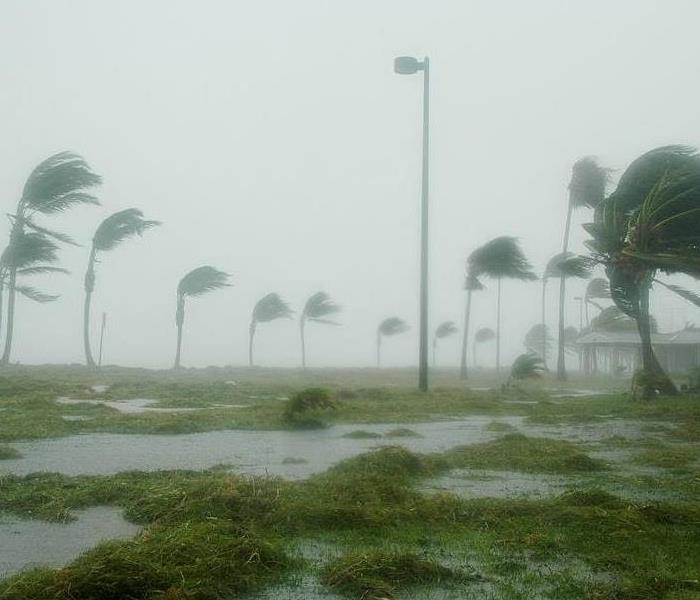 Winds and rain in a hurricane.
Winds and rain in a hurricane.
In the past few months, New Jersey has been experiencing a high level of heavy rainfall. Did you know heavy rainfall and subsequent flooding is one of the common types of damage from storms? There are ten common types of storms and being familiar with them aids in storm preparation and damage prevention.
We know how important it is to homeowners to keep homes safe from storm damage.
The 5 most common storms are:
- Hurricanes
- Tornadoes
- Thunderstorms
- Snow storm
- Hail storms
The fact is that hurricanes cause damage far past the coast. That storms cause damage is obvious, but the kinds of damage they cause and how is not always known.
Since hurricanes have long-term effects (Hurricane Sandy impacted 24 states), it’s very important to be educated on that type of storm in particular.
Hurricane damage is caused by three distinct but related storm elements: storm surge, floods, and wind.
Storm surge is when water rises far past the predicted tide level. This rise occurs because the wind from the hurricane pushes the water toward the shore, giving it nowhere to go, except up and in. The force of storm surge can be so strong as to destroy buildings and roads.
Storm surge is a direct cause of floods. The extra water from storm surge can reach far inland, causing widespread floods as it goes. Hurricanes can also cause rainfall as far as 100 miles past where the hurricane actually hits. Even tropical storms that don’t reach hurricane level can cause excess rainfall and thus floods.
Wind from hurricanes can reach speeds of 74 mph up to 155 mph. Winds of this speed cause widespread destruction by uprooting trees, downing power lines, and carrying debris and tossing it against other structures, even causing roofs to lift. It’s not unheard of for hurricane winds to form tornadoes.
Storm surge, floods, and winds can cause damage that is far-reaching, unexpected, and overwhelming. You can take precautions by packing an emergency preparedness kit, installing weather-resistant features to your house, and always following official safety orders or directives.
Storm Safety
7/1/2022 (Permalink)
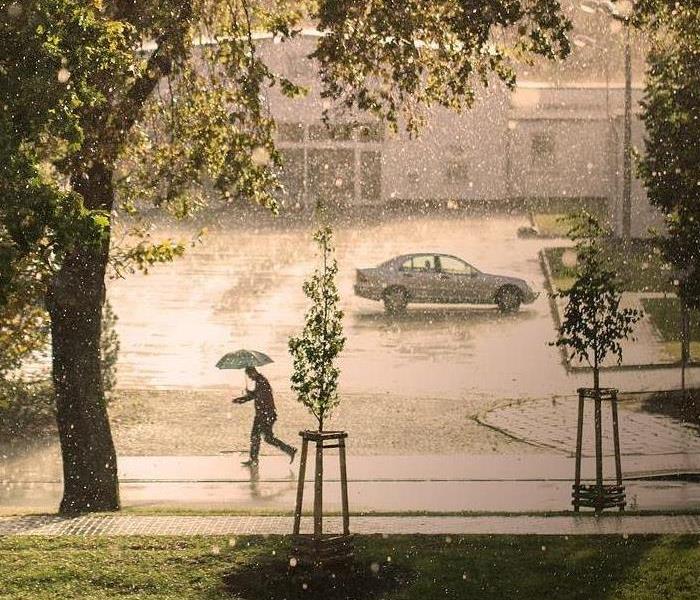 A rainstorm that has the possibility of causing damage.
A rainstorm that has the possibility of causing damage.
What a heat wave we have been experiencing lately in the northeast. I think everyone here in Jersey can agree that it finally feels like summer! We have been experiencing hot sunny weekends in the 90s, impromptu trips to the beach, and endless barbeques. But with hot weather comes brutal showers.
Severe thunderstorms pummeled across New Jersey and the Northeast these last few days, causing flooding on major roads, widespread ongoing power outages, fallen trees and utility lines, damage to homes and even fatality. SERVPRO of Hamilton & South Trenton would like to stress the severity and the potential threat storms can cause.
To keep from putting yourself at risk, we encourage our community to please stay away from storm-damaged areas, downed power lines that can potentially have live wires, and to never drive through a flooded road. During storms, use a battery-operated radio to get updates from local officials. Stay away from windows and doors. Make an emergency supply kit. We recommend having water, non-perishable food, flashlights and extra batteries, clothing and hygiene items, important documents, and cash.
As Always, SERVPRO of Hamilton & South Trenton are here to handle any water damages, no matter the home or business. Give us a call at (609) 604-8241 to set up a free inspection with us. We are here to serve our community!
PREPAREDNESS FOR PETS
6/3/2022 (Permalink)
 Two rottweiler puppies
Two rottweiler puppies
Have you accounted for Fido or Lucy when emergency planning?
After The Storm
After Hurricane Katrina, "It’s estimated that over 15,500 animals were ultimately rescued. Of the 15,500 animals rescued, only 15%-20% were ever reunited with their owners.”
Source: Louisiana Society for the Prevention of Cruelty to Animals, la-spca.org
Pets are just as important as any family member to most people, so why would you not make them a part of your preparedness planning? There are several things you can do to make sure they stay safe as well during an emergency.
Pet Emergency Kit
Ready.gov/pets lists the below items as essential to building your Pet Emergency Kit.
- Food. At least a three-day supply in an airtight, waterproof container.
- Water. At least three days of water specifically for your pets.
- Medicines and medical records.
- Important documents. Registration information, adoption papers, and vaccination documents. Talk to your veterinarian about microchipping and enrolling your pet in a recovery database.
- First aid kit. Cotton bandage rolls, bandage tape, and scissors; antibiotic ointment; flea and tick prevention; latex gloves, isopropyl alcohol, and saline solution. Including a pet first aid reference book is a good idea too.
- Collar or harness with ID tag, rabies tag and a leash.
- Crate or pet carrier. Have a sturdy, safe crate or carrier in case you need to evacuate. The carrier should be large enough for your pet to stand, turn around and lie down.
- Sanitation. Pet litter and litter box if appropriate, newspapers, paper towels, plastic trash bags and household chlorine bleach.
- A picture of you and your pet together. If you become separated, a picture of you and your pet together will help you document ownership and allow others to assist you. Add species, breed, age, sex, color, and distinguishing characteristics.
- Familiar items. Familiar items, such as treats, toys, and bedding can help reduce stress for your pet.
Evacuations
While practicing fire escape or evacuation plans, be sure to include pets. If an evacuation happens, don’t leave pets behind as they can be lost or injured.
Identification
Micro-chipping pets is a great way to locate them. Most veterinary clinics and shelters have scanners that will read the microchip information to help find a pet’s owners.
Be sure to take four-legged friends into consideration when planning for emergencies. Visit ready.gov/pets for further tips and safety precautions to think about for you or your insured’s families’ pets, or your tenant's pets’ during a disaster.
Contact us at 908-650-8611 if you have a service need or click here to visit our website to learn more about SERVPRO of Hamilton, South Trenton's System Services.
The Dangers of Lightning During Storms | SERVPRO® of Hamilton, South Trenton
10/8/2021 (Permalink)
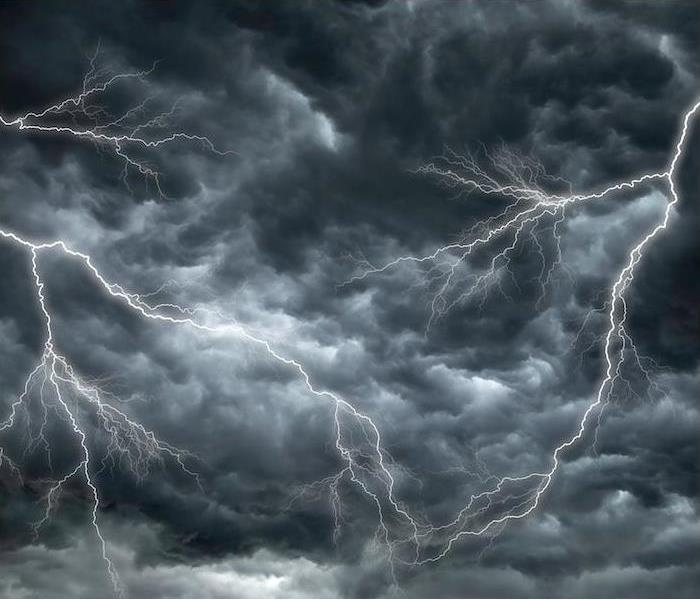 Storm & lightning damage require specialized restoration techniques and equipment. When a storm hits your home, you need the company with experience.
Storm & lightning damage require specialized restoration techniques and equipment. When a storm hits your home, you need the company with experience.
There are many ways in which a thunderstorm can cause damage. Flooding or wind damage are what often come to mind, but it is also important to consider the risks associated with lightning when discussing thunderstorms.
While some storms bring rain and water, every storm is made up of electricity, creating the possibility for lightning even in the absence of precipitation. Lightning bolts can be up to 500,000 degrees, causing damage and even fatalities when they strike. An understanding of what lightning is and how it can be dangerous is extremely helpful in helping homeowners prevent these risks.
How Thunderstorms and Lightning CoexistAll thunderstorms contain the electricity that makes a lightning strike possible. What we know as a lightning strike is actually a rapid burst of electricity that occurs when this charge becomes agitated.
The atmosphere is not an ideal conductor, which is why lightning tends to strike objects—this creates a less resistant route in getting to the ground. When a home is the object that has been struck, lightning will usually forge this path through water pipes and wiring.
How Lightning Is Dangerous to HomesWhile there are many dangers surrounding thunderstorms, there are [three main ones involved with lightning striking a house]:
The risk of fire. One of the biggest dangers of a lightning strike to a house is the fire hazard it causes. Lightning is hot enough to ignite building materials, causing a fire to break out at the point of impact. Additionally, lightning traveling through wires can cause them to fray, creating fire hazards all throughout the home.
The risk of power surges. Because of the electrical charge at play with lightning, it can easily transfer that to the wiring in the home. This is what we call a power surge, which can affect any electronic device plugged in that is not routed through a surge protector.
The risk of shock waves. Shock waves are typically manifested in thunder, but they can also occur at the site of a lightning strike. Shock waves have been known to crack chimneys, break windows and explode cinder blocks, making them extremely hazardous to a home’s structure.
If your home has been affected by storm damages or lightning-related fires, give us a call today! We are experts in damage cleanup and can restore your damage quickly.
Storm Damage: What are the Causes? SERVPRO of Hamilton & South Trenton
7/20/2021 (Permalink)
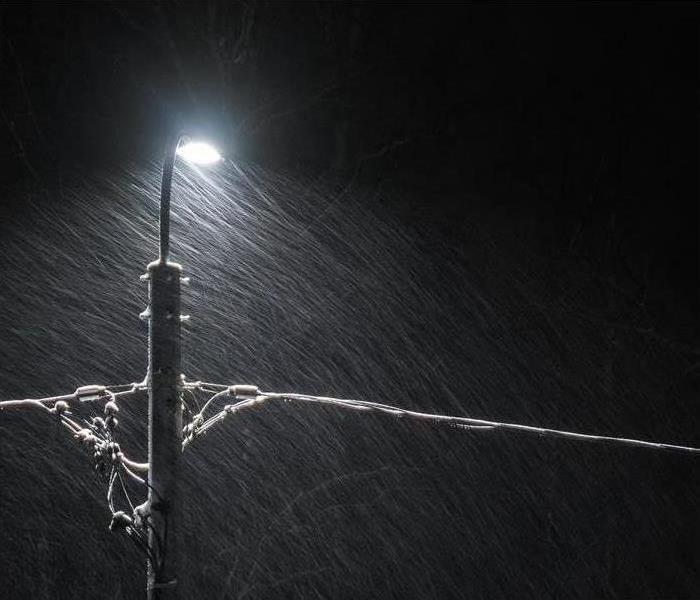 When disaster strikes, we strike back!
When disaster strikes, we strike back!
In the past few months, New Jersey has been experiencing a high level of heavy rainfall. Did you know heavy rainfall and subsequent flooding is one of the common types of damage from storms? There are ten common types of storms and being familiar with them aids in storm preparation and damage prevention.
We know how important it is to homeowners to keep homes safe from storm damage.
The 5 most common storms are:
- Hurricanes
- Tornadoes
- Thunderstorms
- Snow storm
- Hail storms
Since New Jersey is so far north and so close to the coast, it’s very possible that you may experience each of these kinds of events.
The fact is that hurricanes cause damage far past the coast. That storms cause damage is obvious, but the kinds of damage they cause and how is not always known.
Since hurricanes have long-term effects (Hurricane Sandy impacted 24 states), it’s very important to be educated on that type of storm in particular.
Hurricane damage is caused by three distinct but related storm elements: storm surge, floods, and wind.
Storm surge is when water rises far past the predicted tide level. This rise occurs because the wind from the hurricane pushes the water toward the shore, giving it nowhere to go, except up and in. The force of storm surge can be so strong as to destroy buildings and roads.
Storm surge is a direct cause of floods. The extra water from storm surge can reach far inland, causing widespread floods as it goes. Hurricanes can also cause rainfall as far as 100 miles past where the hurricane actually hits. Even tropical storms that don’t reach hurricane level can cause excess rainfall and thus floods.
Wind from hurricanes can reach speeds of 74 mph up to 155 mph. Winds of this speed cause widespread destruction by uprooting trees, downing power lines, and carrying debris and tossing it against other structures, even causing roofs to lift. It’s not unheard of for hurricane winds to form tornadoes.
Storm surge, floods, and winds can cause damage that is far-reaching, unexpected, and overwhelming. You can take precautions by packing an emergency preparedness kit, installing weather-resistant features to your house, and always following official safety orders or directives.
Making Sure Your Family is Prepared for Severe Weather | SERVPRO® of Hamilton & South Trenton
7/20/2021 (Permalink)
 Having a team on your side after a disaster can help relieve stress. SERVPRO of Hamilton, South Trenton is here to help 24/7.
Having a team on your side after a disaster can help relieve stress. SERVPRO of Hamilton, South Trenton is here to help 24/7.
Today, we are fortunate to have advance warning for some types of severe weather, but there are also times where Mother Nature manages to catch us by surprise.
Fortunately, there are steps you can take and safety tips to follow that will guide you in preparing for your family’s safety in various severe weather occurrences.
Where to Start
One of the best ways to ensure your family’s safety is to have an established family emergency plan at the ready.
Be sure to go over your plan together as a family at the beginning of each weather season if there is an emergency plan in place so everyone knows exactly what to do.
Here are some things to take into consideration when creating your family emergency plan if you have not yet done so:
1. How will emergency alerts and warnings be received?
Thanks to technology today, emergency alerts and warnings are at our fingertips with our smartphones that are equipped with a weather app or Google. We can quickly receive emergency alerts, that provide us with valuable time in severe weather situations. Warnings and alerts are also still broadcast over radio and TV.
2. What type of storm shelter do you have?
Where tornadoes are a common occurrence, you’ll want to be in the lowest part of your home, preferably a basement, or if there is no basement, use an interior room on the lowest level that is away from corners, windows, doors and outside walls. Tornadoes aren’t the only weather circumstance that require a form of storm shelter, and you can learn about more of the situations that call for them by visiting ready.gov.
3. What are the evacuation routes?
Have you mapped out multiple evacuation routes because hurricanes, flooding and fires can force you from your home at a moment’s notice. It’s wise to have multiple routes in the event one is impassable, and be sure you find places to stay with your pets along the way if you have furry family members involved in your evacuation.
4. How will everyone stay in touch?
Cell phones are the easiest way to keep in touch with your family, but in some circumstances, that just will not be possible. Cell phone towers can be damaged and phones could be lost or left behind; not to mention batteries will not last forever and there will be no power to recharge them.
Your family should have an emergency communication plan in place as well as a safe meeting place so that you can all meet there if separated.
If a storm does cause damage to your home or business, don’t hesitate to call your friends at SERVPRO® of Hamilton, South Trenton to get the cleanup and restoration process started.
Understanding the Basics of Damaging Winds | SERVPRO® of Hamilton & South Trenton
7/13/2021 (Permalink)
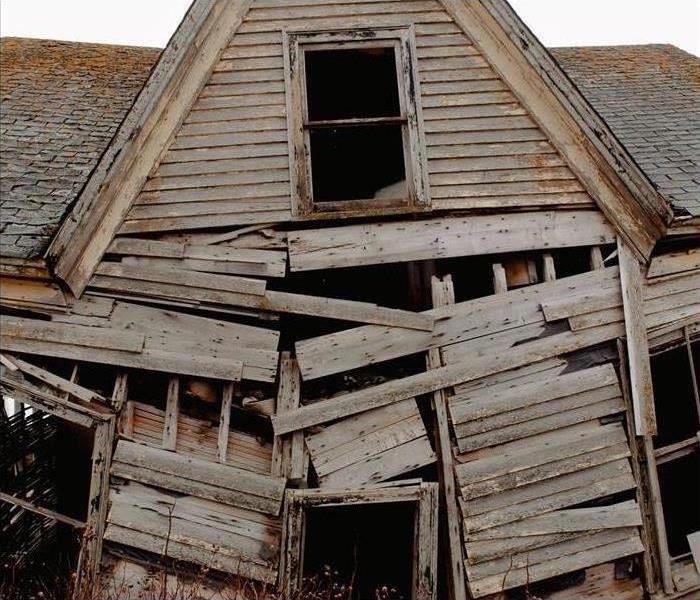 We are available for cleanup & restoration services 24 hours a day, seven days a week.
We are available for cleanup & restoration services 24 hours a day, seven days a week.
Damaging winds are one of the threats that comes with severe storms. These winds can catch you off guard and be problematic due to long-term structural impacts.
Why Damaging Winds Are Such a Major Concern
Tornadoes and hurricanes are not the only times damaging winds occur. Damaging winds are considered winds with wind speeds exceeding 50–60 mph and can be produced by a strong thunderstorm. Often, you will hear damaging winds referred to as “straight-line” winds to differentiate the damage from tornado damage.
The damage from straight-line winds can be especially destructive, often causing unanchored objects to become projectiles. Any windows or roof can take the brunt of this damage. If the damage is extensive, it can result in water damage to the home as outside elements come indoors through broken windows or damaged roofs.
Anyone who lives in a thunderstorm-prone area can be at risk from damaging winds, but there are some structures, such as mobile homes, especially at risk. Mobile homes, even those that are anchored, could sustain serious damage in winds gusting over 80 mph.
Ways to Prepare Your Home
There are a number of things you can do to protect your property from damaging winds, but there are two things to remember, keeping the “Two R’s” in mind: reinforce and remove.
Look into having your garage door reinforced by a professional.
Ensure that any loose objects on your property that could become wind-borne are properly stored or anchored. Remember that trash cans, grills and outdoor furniture are easily picked up by strong winds.
Larger, older decaying trees and branches should be professionally removed, which will ensure they cannot be blown onto your home.
Remember, high winds can occur without advanced notice. By taking some, or all, of the above actions, you can be prepared on a moment’s notice.
Also, if you are building a new home or renovating an older home, be sure windows, walls and doors are up to code for your area.
If your home has been hit by damaging winds and resulting water damage, the highly trained specialists at SERVPRO® of Hamilton & South Trenton are here to help with the cleanup and restoration of your home.
The Dangers of Lightning During Storms | SERVPRO® of Hamilton/South Trenton
7/13/2021 (Permalink)
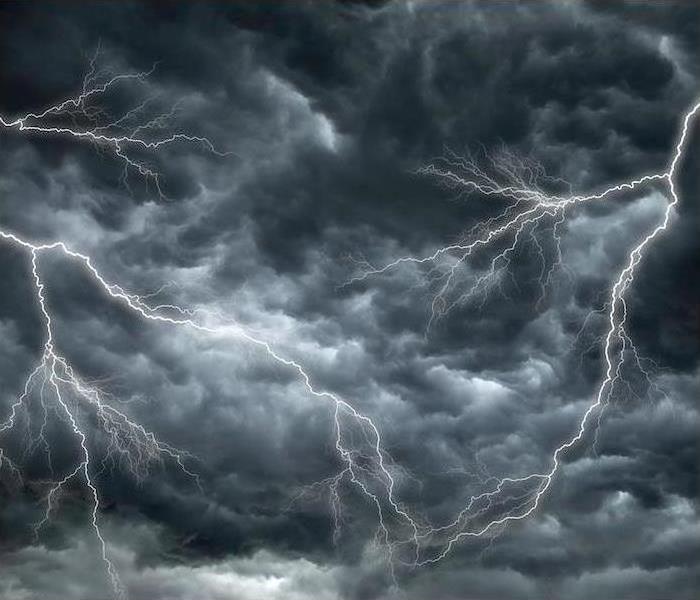 Storm & lightning damage require specialized restoration techniques and equipment. When a storm hits your home, you need the company with experience.
Storm & lightning damage require specialized restoration techniques and equipment. When a storm hits your home, you need the company with experience.
There are many ways in which a thunderstorm can cause damage. Flooding or wind damage are what often come to mind, but it is also important to consider the risks associated with lightning when discussing thunderstorms.
While some storms bring rain and water, every storm is made up of electricity, creating the possibility for lightning even in the absence of precipitation. Lightning bolts can be up to 500,000 degrees, causing damage and even fatalities when they strike. An understanding of what lightning is and how it can be dangerous is extremely helpful in helping homeowners prevent these risks.
How Thunderstorms and Lightning Coexist
All thunderstorms contain the electricity that makes a lightning strike possible. What we know as a lightning strike is actually a rapid burst of electricity that occurs when this charge becomes agitated.
The atmosphere is not an ideal conductor, which is why lightning tends to strike objects—this creates a less resistant route in getting to the ground. When a home is the object that has been struck, lightning will usually forge this path through water pipes and wiring.
How Lightning Is Dangerous to Homes
While there are many dangers surrounding thunderstorms, there are [three main ones involved with lightning striking a house]:
The risk of fire. One of the biggest dangers of a lightning strike to a house is the fire hazard it causes. Lightning is hot enough to ignite building materials, causing a fire to break out at the point of impact. Additionally, lightning traveling through wires can cause them to fray, creating fire hazards all throughout the home.
The risk of power surges. Because of the electrical charge at play with lightning, it can easily transfer that to the wiring in the home. This is what we call a power surge, which can affect any electronic device plugged in that is not routed through a surge protector.
The risk of shock waves. Shock waves are typically manifested in thunder, but they can also occur at the site of a lightning strike. Shock waves have been known to crack chimneys, break windows and explode cinder blocks, making them extremely hazardous to a home’s structure.
If your home has been affected by storm damages or lightning-related fires, give us a call today! We are experts in damage cleanup and can restore your damage quickly.
Understanding Thunderstorm Damage | SERVPRO of Hamilton & South Trenton
6/7/2021 (Permalink)
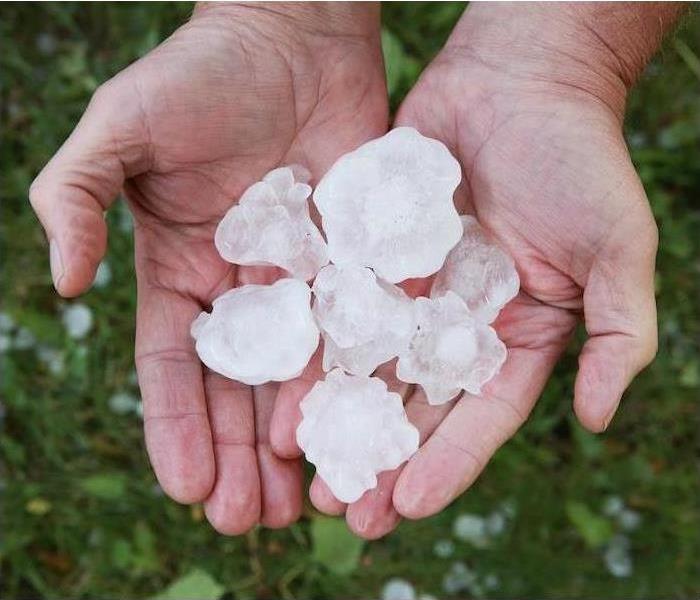 If a thunderstorm has resulted in damage to your home or business, know our team is available 24/7 to help with cleanup and restoration.
If a thunderstorm has resulted in damage to your home or business, know our team is available 24/7 to help with cleanup and restoration.
Thunderstorms are a regular occurrence during the warmer spring and summer seasons, bringing along the risk of damage to your property.
Thunderstorms come in varying levels of intensity. Do you know what those are?
Understanding Thunderstorms
Across the world, an average of 16 million thunderstorms occur each year. The U.S. can see upward of 100,000 thunderstorms annually, with an estimated 10% earning severe status.
Thunderstorms need certain conditions to be met in order to form. Moisture and rising unstable air are required, along with a “lifting” mechanism, which could be things like hills or mountains that force air to rise, or where warm/cold or wet/dry air bump together, causing that rising motion.
There are three stages in a thunderstorm’s life cycle. Those are the developing stage, the mature stage and the dissipating stage. It is during the mature stage that things like hail, strong rain, lightning, high winds and tornadoes are most likely to occur.
Common Types of Damage
Thunderstorms can prove dangerous in many different ways, but an extremely serious threat stems from the possibility of seeing flying debris due to high winds.
During severe storms, wind can see speeds in excess of 57.5 mph, and that is certainly high enough to result in damage to your property.
Even the most unexpected items could reach projectile status during a high wind situation. A smart thing to do is make sure you have scouted your yard for items that could turn dangerous, such as tree branches, lawn furniture, and fencing, and then taken steps to secure them before a storm comes into town.
Besides wind damage, thunderstorms can also produce these types of damage:
Lightning damage. Not only can lightning strikes cause a fire, they can also wreak havoc on your electrical systems. Since a lightning strike can pass through the wiring of your home, it can lead to the damage of anything plugged in.
Tornado damage. With wind speeds that can reach as high as 200 mph, tornadoes are especially destructive. They are able to cover a large area and do their damage in a limited amount of time.
Hail damage. Believe it or not, hail damage can top out around $1 billion a year. Small hail can damage crops throughout the country, while larger hail can damage vehicles, roofing and windows.
Flood damage. Rain almost always accompanies a storm, so it should not come as a surprise that heavy rains can turn into flood danger. Flash flooding can have the strength to rip trees out of the ground and sweep items and structures away.






 24/7 Emergency Service
24/7 Emergency Service
















